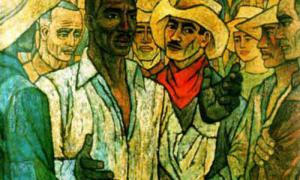
With a solemn march to Manzanillo railway station and a national act, Cubans of several generations paid tribute to the sugar workers’ leader Jesús Menéndez Larrondo, on the 70th anniversary of his assassination.
The march was preceded by a solemn rally in front of the Fraternidad del Puerto former trade union premises, to where the angry people moved the body of the proletarian leader, after snatching it from the Rural Guard on the same night of the crime, January 22, 1948.
Before the monolith that remembers the martyr in the exact place where the Captain of the Rural Guard, Joaquín Casillas Lumpuy, ended his life, thousands of workers, students, combatants and others dedicated songs, dances and poems to the labor hero, including the placing of a floral wreath on behalf of the Cuban people by Federico Hernández, Party first secretary in Granma; Orlando Celso García, president of Azcuba, and Ismael Druyet, member of the National Secretariat of the Cuban Workers’ Federation.
Elizabeth Mendoza, a worker at the Enidio Díaz Machado sugar mill, in the municipality of Campechuela, stated that “The best monument we can build is to study more, always better ourselves, be responsible technicians or professionals and achieve efficiency in the sugar sector.”
José Antonio Pérez, secretary general of the National Union of Sugar Workers, affirmed that the ideals and work of Menéndez should be honored in each sugar mill, plantation, production unit and supporting enterprise, with daily efforts to advance the sector.
Meanwhile, in the Havana headquarters of the Union of Writers and Artists of Cuba (UNEAC), tribute was also paid to Menéndez, known as the “General of the Sugar Canes,” following the poem by Nicolás Guillén, a beautiful elegy that immortalized him in verse.
In the brief act organized by the Aponte Commission, the Nicolás Guillén Foundation and UNEAC itself, poet Miguel Barnet, president of the latter, recognized the transcendental values of Jesús Menéndez’s work and recalled the day he was buried and the huge crowd that accompanied him to his final resting place, only comparable to those that attend important acts of the Cuban Revolution. Like Guillén, he also remains alive among us, he concluded.















